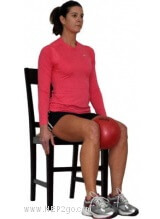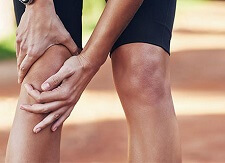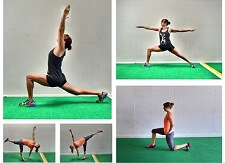- Home
- Knee Exercise Guide
- Kneecap Exercises
Knee Cap Exercises
for Patellar Maltracking
Written By: Chloe Wilson, BSc(Hons) Physiotherapy
Reviewed by: KPE Medical Review Board
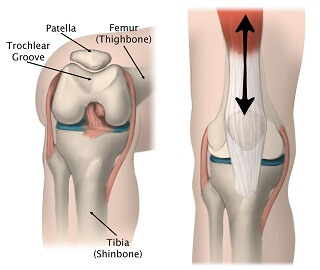
Knee cap exercises can be really helpful in reducing knee pain and correcting patellar maltracking. They aim to strengthen the VMO muscles (Vastus Medialis Oblique) around the patella improving how the kneecap moves.
The VMO muscles are part of the quadriceps muscles and are found on the inner side of the knee. Their job is to control the kneecap movement, known as patellar tracking. They hold the kneecap in the middle of the patellar groove so it glides smoothly during any leg movement.
If the kneecap muscles are weak, the
kneecap shifts slightly to the outer side of the knee. This prevents it from moving properly, known as patellar maltracking, which
leads to pain and irritation.
Knee cap pain is common and is often caused by conditions such as Runners Knee and Chondromalacia Patella.
Why Do Knee Cap Exercises?
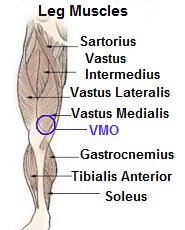
The VMO muscles should be working the whole time when the knee moves, but if there is knee pain or there has been a kneecap injury such as a dislocation, they often switch off and stop working properly.
Regular quads strengthening exercises e.g. squats and lunges, don’t specifically target the VMO muscles. They need to be strengthened in a slightly different way.
Here you will find some easy to
perform yet effective knee cap exercises for the VMO muscles. They will
improve your patellar tracking and the stability of your knee.
How To Target Knee Cap Muscles
Before you can strengthen the knee cap muscles, you need to know how to make sure they are working.
Sit comfortably in a chair and put your fingers at the top of your kneecap. Move your fingers up an inch, and inwards an inch so you are on a soft fleshy bit – this is the VMO. Push your knee and foot down into the floor and you should feel the muscle tighten/clench under your fingers.
It might take a few goes before you feel this – keep practising.
When you are doing any of the knee cap exercises below, keep checking
that you can feel the VMO muscles working.
Top 3 Knee Cap Exercises
Once you are happy that your VMO muscles are working, you can start doing these knee cap exercises. Get the hang of stages 1 and 2 before moving on to stage 3.
1. VMO Stage 1 - Sitting
Starting Position: Sit in a chair, feet hip width apart with a soft football in between your knees
Action: Clench your buttocks, clench your knees and gently squeeze the ball with your knees. Hold for 3-5 secs and relax
Repetition: Repeat 10-20x, 2x daily
Tips: 1. Feel for the VMO muscle tightening with your fingers
2. When you squeeze the ball, make sure the squeezing movement comes from your knees, not your hips
2. VMO Stage 2 - Lying
Starting Position: Lying on your back with a pillow under your knees. Feet hip width apart with a soft football in between your knees
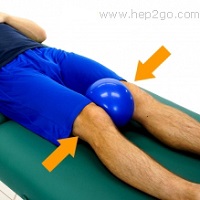
Action: Clench your buttocks, clench your knees and gently squeeze the ball with your knees. Hold for 3-5 secs and relax
Repetition: Repeat 10-20x, 2x daily
Progression: Start with rolled up towel underneath your knees they are bent 30°. Squeeze the football as before and then lift the foot of the weak leg up off the bed, straightening the knee, maintaining the squeeze on the ball. Hold for 3 secs, slowly lower the leg and finally relax the knee.
Top Tips: 1. Ensure that you keep squeezing the ball throughout knee cap exercises – keep the knee and buttock clench going throughout.
2. Keep the knee resting on the pillow – do not lift it up
3. VMO Stage 3 - Standing
Starting Position: Stand with your back against the wall, feet hip width apart about 10cm away from the wall. Place a soft football in between your knees
Action: Squeeze the ball as with stage 1 & 2 (clench knees and buttocks) and then slowly squat down as far as comfortable. Hold for 3 secs and come back up
Repetition: Repeat 10-20x, 2x daily
Progression: Progress the exercise by gradually increasing the depth of the squat but take care not to aggravate your knee pain.
What Else Can Help?
Once you have got the hang of these knee cap exercises you can incorporate the VMO clenches into your other exercises such as squats and lunges. For a greater range of exercises, check out the Vastus Medialis exercises article.
You can also visit the knee cap pain section to find out more about the common causes of patella problems.
Page Last Updated: 11/09/21
Next Review Due: 11/09/23
